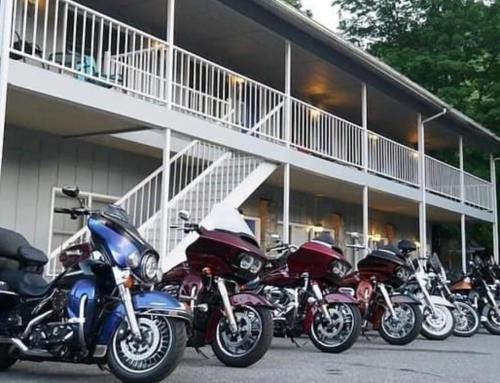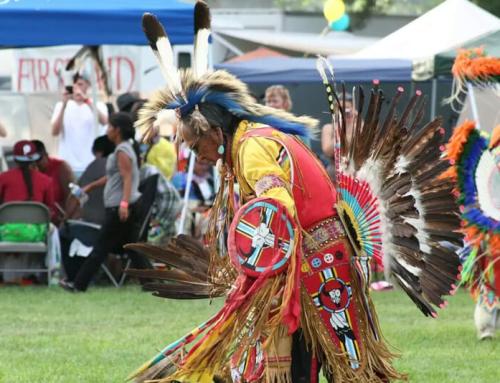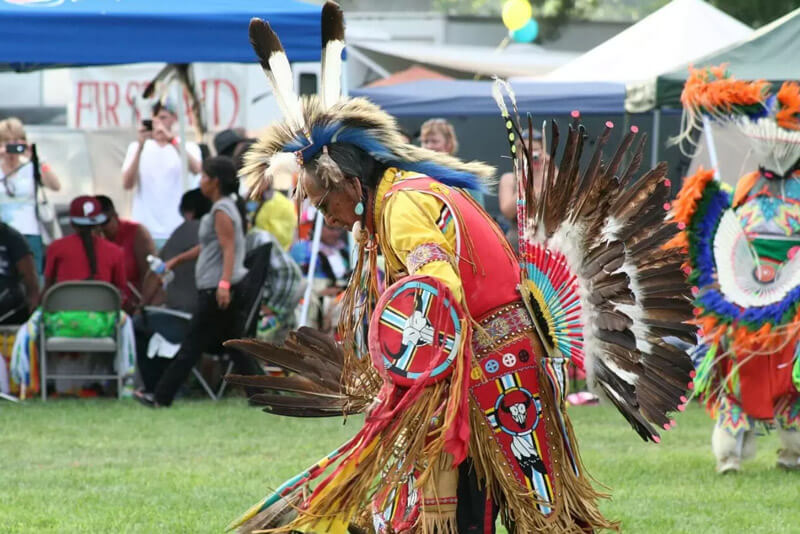
Cherokee Heritage and Cultural Expert
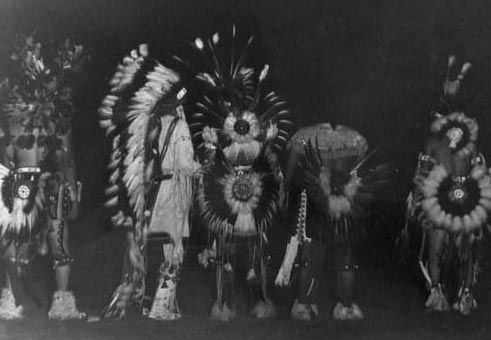
In 1650 it is estimated that close to 23,000 tribal members inhabited this massive area that they called home, while often ranging even further in every direction to trade, hunt and wage war.
But it is the Great Smoky Mountain range –specifically the Qualla Boundary and nearby surrounding areas – that the tribe consider their motherland, their sacred home. And it is where many of them still reside today.
Living Traditions and Multi-Cultural Diversity
Multiple dynamic cultures originating from across the globe, make up the diverse human population of today’s longtime residents of the Great Smoky Mountain region. Nestled deep in the lofty peaks, lush river valleys and dark hollows of southern Appalachia, it is land like no other.
As interesting as all of these cultures and their respective traditions are, and as many contributions that they have all made to the hallowed and storied history of the Great Smokies, none have been here longer, or can surpass the story and rich cultural history of the “real or principal people,” or “Aniunwiya” in the Cherokee tongue. They are more commonly known today as the Eastern Band of the Cherokee Tribe.
The members of this sovereign nation live on the Qualla Boundary –a land of incredible natural beauty, teeming with elk, bear, deer, rattlesnakes, copperheads, trout, frogs, turtles, hellbenders, bald eagles, ravens, hawks, turkeys and countless other flying, crawling, walking, running and swimming species, as well as numerous forms of trees, flowers, fruit, fauna and insects—some found nowhere else. All of them co-existing in one of the world’s most unique and diverse eco-systems – the land the Cherokee appropriately called “shaconage” or land of blue smoke.
Cherokee Cultural Heritage
It is a region and a people that is steeped in ancient tribal history, storytelling, craftsmanship and art. An area that includes the original sacred mother town of the tribe –“Kitawuh” –and locations integral in tribal history such as Clingman’s Dome originally known as “Kuwahi” in Cherokee. A 6,000 feet peak of huge historical significance to the Real People that loomed over a magical lake where the “Aniunwiya” believed wounded and dying animals could immerse themselves and emerge healed and whole.
It is a magical and mystical place where legend maintains that the “Yunwi Tsundi” or Little People, a group of dwarf like tricksters, lived in the deepest forests, while a slant eyed giant known as “Judaculla” once stomped his massive feet across the tops of these high peaks leaving his footprints –and even hand prints and mysterious writing on a boulder for all to see.
Some believe these mythical legends still roam these hills today. And indeed, many Cherokee believe that proof of “Judaculla’s” existence remains on a massive boulder in Jackson County, N.C. today –known as Judaculla Rock.
“Shaconage” and the story of the “real people” is a tale of real-life tragedy and triumph. A beloved land, treasured, fought for, almost lost forever and eventually regained, due to the perseverance, intelligence, bravery, and tenacity of their storied people. A people fiercely committed to perpetuating the legacy, crafts, traditions, dialect and stories of their legendary tribe.
A people obligated to pass and teach this knowledge and these traditions through their beloved elders to younger generations to ensure that these tribal traditions live forever.
Matrilineal Society and Respect for Elders
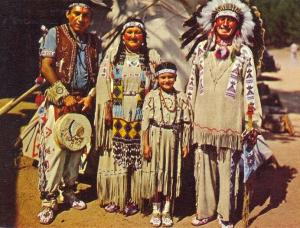
Image Credit: http://nativeamericannetroots.net/diary/2207
The Cherokee have always been a matrilineal society that held women in high regard and revered and respected all tribal elders for their wit and wisdom. One of the most esteemed titles a Cherokee person –male of female—can hold is that of Beloved Woman or Beloved Man of the people.
The title is one not easily or quickly given. Only the most elite of Cherokee tribal members can qualify for this honor bestowed to them only after careful deliberation and consideration by the Cherokee Tribal Council before being approved by the tribe. It can only be earned after demonstrating a lifetime of selfless service to their people.
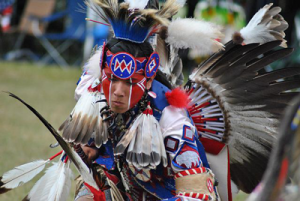
It is an honor dating back to the mid-18th century—probably before—when we first have record of celebrated chiefs like Little Turkey and the Great Warrior of Chota, Oconostota, along with Nancy Ward, and others, first having the award bestowed upon them.
A few more recent winners of this elite designation include Steve Youngdeer, Jerry Wolfe, Amanda Swimmer, Ella Bird, Maggie Wachacha, Myrtle Johnson, Shirley Oswalt and Lt. Colonel Kina Swayney –among others, with undoubtedly more to come in the future.
Esteemed Cherokee Artist and Storyteller
Esteemed historian, storyteller, craftsman and humanitarian, Davy Arch is not yet among their storied ranks. But he certainly is building a remarkable lifetime body of work that could make him worthy of consideration someday.
But in the meantime, the Meadowlark Smoky Mountain Heritage Center is honored to include him as a member of our esteemed artist roster, and prouder still, to call him a friend.
Davy Arch grew up on a subsistence farm in the Paint Town Community on the Qualla Boundary. It was there, along the banks of Stillwell Branch, tucked deep in the Smokies, that Davy first learned ancient tribal customs and stories, as well as how to hunt, fish, and farm, along with identifying and harvesting medicinal plants to use as a practitioner of tribal medicine, as he refined his primitive survival skills.
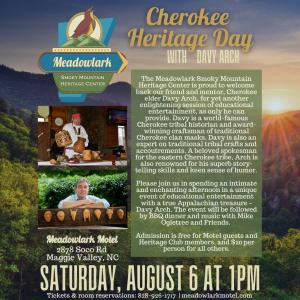
Soon, Davy was creating tribal clan masks made of native wood such as buckeye, cherry, pine and walnut that were recognized as true works of art. He won the Grand Prize for wood carving at the Cherokee Indian Fair in 1979 and displayed his work at the World’s Fair in Knoxville, Tennessee in 1982.
Arch later became Director of Education for Qualla Arts and Crafts and became a founding member of the Cherokee Potters Guild. His work quickly became coveted in shops, museums and galleries across the region, and would eventually be displayed in renowned galleries and museum nationwide –including the Kennedy Center, Smithsonian Institute, just to name a few.
Meanwhile, Arch was refining his skills as an orator, historian and storyteller, rapidly becoming famous for his vast knowledge of tribal history, complimented by his keen wit and eloquent yarn spinning skills as a feature lecturer and storyteller with NCCAT and National Public Radio while serving as an artist in residence for enthusiastic audiences across North Carolina and around the globe.
Telling the Cherokee Stories of Art, History and Culture
Few artists of any culture, have the skills to manually create complex, elaborate cultural works of art worthy of inclusion in world class venues. Fewer still, have the capability to eloquently articulate the stories behind their art, while conveying the poignant history of his storied people, and in an engaging, informative manner that can produce both laughter and tears in the same program. Davy Arch is truly a world class historian, artist, and lecturer, and indeed, a national treasure.
Today Davy Arch is an esteemed artist whose work and programs are appreciated by friends, fans and followers not just in the Smokies, but worldwide. With one foot firmly entrenched in preserving his past, and the other immersed deeply in perpetuating that legacy for future generations.

A Renaissance man in the truest and best sense of the word. Davy Arch is an iconic artist who has remained true to his roots, a man who represents all that is good and true about the human race. A ray of shining light in often turbulent times, inspiring all of us lucky enough to know him and call him friend.
Meet Davy Arch
Don’t miss this unique opportunity to meet and learn from one of the foremost Cherokee artists and historians in the world today, as we welcome Davy Arch to the Meadowlark Smoky Mountain Heritage Center stage on Saturday, August 6, at 1:00 PM.
Spend an enchanting afternoon with Davy and then stay for music and BBQ later that evening—all included with your 20-dollar ticket – free to motel guests and Heritage Club Members. Call 828-926-1717 or visit www.meadowlarkmotel.com for further details.
Author Bob Plott –Author and Historian –GM of Meadowlark Smoky Mountain Heritage Center at the historic Meadowlark Motel.





